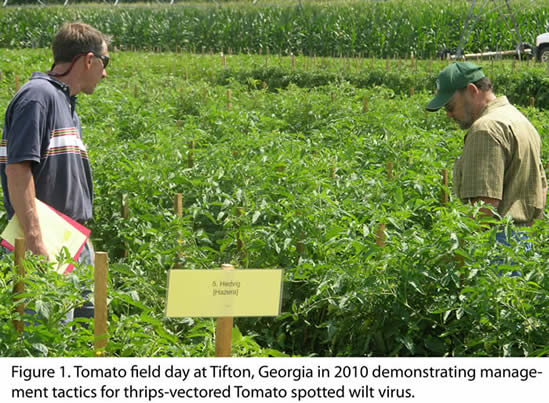About
Fresh tomato and pepper production in the USA has an annual value of approximately $2 billion with Florida, Georgia, South Carolina and North Carolina, comprising approximately 43% of the national production of these two crops (15). Tomato and pepper integrated pest management programs are critical to maintaining a viable production system in the Southeast because just as the warm-wet conditions provide for lush growth of these crops, so too does it provide for plentiful insect and disease problems. In the late 1990’s, an increase in thrips-related problems involving the transmission of Tomato spotted wilt virus (TSWV) which causes the tomato spotted wilt (TSW) disease lead to intensive pesticide use, economic losses, and severe challenges to production not only in vegetables, but most notably in peanut and tobacco.
 In response, the scientists at University of Georgia, University of Florida, Clemson University, and University and North Carolina State University and from other state agencies in the Southeast have spent the better part of two decades trying to solve this insect transmitted virus disease and transfer this information to growers through vegetable field days (Fig. 1) and other media such as this website.
In response, the scientists at University of Georgia, University of Florida, Clemson University, and University and North Carolina State University and from other state agencies in the Southeast have spent the better part of two decades trying to solve this insect transmitted virus disease and transfer this information to growers through vegetable field days (Fig. 1) and other media such as this website.
This website is the culmination of years of research and extension efforts by the research and extension teams dealing with thrips-vectored TSWV in tomato and pepper from Florida, Georgia, South Carolina and North Carolina. A significant portion of the information was developed as part of a USDA RAMP 2008-2012 funded project entitled, “A Reduced-Risk System for Managing Thrips and Tomato Spotted Wilt Virus in Tomato and Pepper in the Southeastern U.S.A.” The integrated pest management approach to this pest problem involves forecasting when the thrips vectors occur relative to tomato and pepper production in the Southeast, assessing potential severity of the disease, identifying management tactics that consistently mitigate the negative effects on crop production quality and providing decision criteria for the best use of these tactics. The management tactic that has been most effective in peanut, tomato and pepper has been host plant resistance to TSW. The effectiveness of this tactic has been attested by the reduction in losses due to TSW in these crops over the last decade (see Fig. 2 for example data in peanut). It is important have a management system clearly documented as we move forward since the pest situation can always change. For example, if host plant resistance to TSW in tomato were to be lost through adaptation of the virus, a comprehensive approach with multiple tactics will help reduce losses and allow pest managers to continue to adapt to the problem.
The best way to use this website is as a starting point to the other material in the literature and on the web. As new TSW management information arises, this will be posted or linked from this site. Interactive links dealing with thrips forecasting will only be available on line due to the temporal nature of these data. Also, be aware that the RAMP Team members listed in the back of this publication are simply those researchers and extension specialists involved in the original project. In the first chapter on history and economic impact we discuss TSW incidence in peanut and tobacco in addition to vegetables. This is because much of the historical incidences and early economic impact of this pest problem first arose in these other cropping systems. Also, the TSW incidence in tobacco is a better indicator of overall severity of the virus over time because tobacco does not currently have host plant resistance to TSW in commercial cultivars. Since the tobacco survey was conducted over a large scale, it provides representative disease severity data for the Southeast. In vegetables, the two crops most severely affected in the Southeast have been tomato and pepper. These are also two of the most economically important vegetable crops based on farm-gate value in the region.
